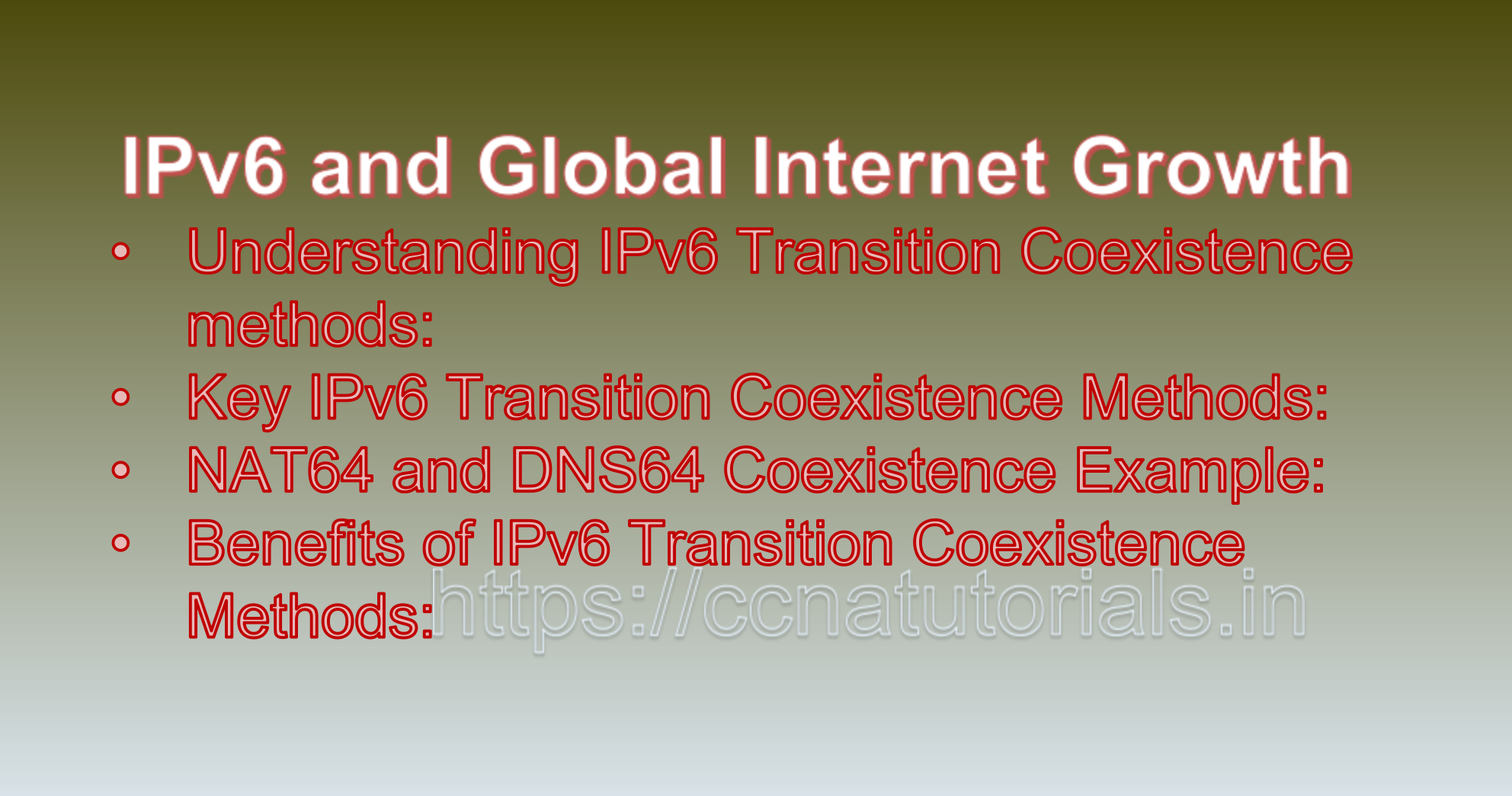Contents of this article
In this article, I describe IPv6 Transition Coexistence Methods: Ensuring Smooth Migration in a Dual-Stack World. The transition from Internet Protocol version 4 (IPv4) to Internet Protocol version 6 (IPv6) is a complex undertaking due to the coexistence of both protocols during the migration process. To facilitate this transition, various coexistence methods have been developed. These methods enable networks, devices, and services to operate seamlessly in a dual-stack environment, where both IPv4 and IPv6 are supported. This article explores the importance of IPv6 transition coexistence methods and provides examples of how organizations can navigate the coexistence phase effectively.
1. Understanding IPv6 Transition Coexistence methods:
IPv6 adoption involves a period during which both IPv4 and IPv6 coexist on the network infrastructure, devices, and services. Coexistence methods ensure that communication remains possible between systems using either protocol. This coexistence phase allows organizations to gradually migrate to IPv6 while maintaining connectivity with IPv4-based systems.
2. Key IPv6 Transition Coexistence Methods:
– Dual-Stack:
In a dual-stack environment, networking devices, servers, and clients are configured to support both IPv4 and IPv6. This method allows devices to choose the appropriate protocol based on the destination’s capabilities.
– Tunneling:
Tunneling involves encapsulating IPv6 packets within IPv4 packets to traverse IPv4-only networks. This allows IPv6 traffic to be carried over IPv4 infrastructure until the entire path supports IPv6.
– NAT64 and DNS64:
Network Address Translation IPv6 to IPv4 (NAT64) and DNS64 are used together to enable IPv6-only clients to communicate with IPv4 servers. NAT64 translates IPv6 addresses to IPv4 addresses, while DNS64 synthesizes IPv6-style addresses for IPv4-only services.
– 6to4:
The 6to4 method allows IPv6 packets to be encapsulated within IPv4 packets. This enables direct communication between IPv6-enabled sites across IPv4 infrastructure.
– ISATAP (Intra-Site Automatic Tunnel Addressing Protocol):
ISATAP facilitates IPv6 communication within a single site using IPv4 infrastructure. It creates tunnels that allow IPv6 packets to traverse IPv4 networks.
3. Dual-Stack Coexistence Example:
– Corporate Network: A corporation is migrating to IPv6. During the coexistence phase, the IT department configures all networking devices, servers, and clients to support both IPv4 and IPv6. As a result, devices can communicate using the appropriate protocol based on the destination’s capabilities.
4. Tunneling Coexistence Example:
– International Offices: A multinational company has IPv6-enabled headquarters but IPv4-only branch offices in some countries. To enable communication between the headquarters and the IPv4-only branches, the company deploys tunneling solutions that encapsulate IPv6 packets within IPv4 packets, allowing IPv6 traffic to traverse the IPv4 networks.
5. NAT64 and DNS64 Coexistence Example:
– Mobile Network Provider: A mobile network provider wants to offer IPv6 services to its customers. However, many online services and websites are still IPv4-only. The provider implements NAT64 and DNS64 to allow IPv6-only customers to access IPv4 services seamlessly.
6. 6to4 Coexistence Example:
– Global Business: An international business with multiple locations worldwide has IPv6-enabled headquarters. It uses the 6to4 method to establish direct communication between its IPv6-enabled sites across IPv4 networks, ensuring connectivity regardless of the intermediate IPv4 infrastructure.
7. ISATAP Coexistence Example:
– University Campus: A university campus is transitioning to IPv6. It uses ISATAP to facilitate IPv6 communication within its campus network using the existing IPv4 infrastructure. This allows IPv6-enabled devices on campus to communicate without requiring immediate deployment of native IPv6 connectivity.
8. Benefits of IPv6 Transition Coexistence Methods:
– Gradual Migration: Coexistence methods allow organizations to transition to IPv6 gradually, ensuring a smooth migration process without disrupting network operations.
– Maintained Connectivity: These methods enable networks to maintain connectivity with both IPv4 and IPv6 systems, ensuring that services continue to function during the transition phase.
– Compatibility: Coexistence methods ensure that devices and services designed for IPv4 can interact with IPv6-based systems and vice versa.
9. Case Study: ISP Transition to IPv6:
An Internet Service Provider (ISP) is transitioning its network to support IPv6. The ISP uses a combination of coexistence methods to ensure a seamless migration process.
Implementation:
– The ISP deploys dual-stack configurations on its networking devices, enabling them to support both IPv4 and IPv6 traffic simultaneously.
– For IPv6-only destinations, the ISP uses tunneling to encapsulate IPv6 packets within IPv4 packets when traversing IPv4-only segments.
Benefits:
– Customers can continue to access both IPv4 and IPv6 services during the migration, ensuring a smooth transition without service disruptions.
– The ISP’s network remains compatible with both protocols, facilitating communication with systems using either IPv4 or IPv6.

In short IPv6 Transition Coexistence Methods, Navigating the Coexistence Phase with Confidence
IPv6 transition coexistence methods are integral to the successful adoption of IPv6 while ensuring continued connectivity and compatibility with IPv4-based systems. Organizations can leverage these methods, such as dual-stack configurations, tunneling, NAT64/DNS64, 6to4, and ISATAP, to navigate the coexistence phase effectively. By implementing these methods, organizations can maintain uninterrupted service delivery, enable gradual migration, and ensure a seamless transition to the future of networking. Coexistence methods play a pivotal role in facilitating the evolution of internet communication toward the expanded capabilities of IPv6.
IPv6 Transition and Coexistence Methods: Bridging the Gap Between IPv4 and IPv6
The transition from Internet Protocol version 4 (IPv4) to Internet Protocol version 6 (IPv6) is driven by the need to accommodate the increasing number of internet-connected devices and the exhaustion of available IPv4 addresses. However, during the transition phase, it’s essential to ensure that both IPv4 and IPv6 can coexist harmoniously to maintain network connectivity and functionality. Various transition and coexistence methods facilitate this process, enabling organizations to smoothly migrate to IPv6 without disrupting existing IPv4 services. This article explores IPv6 transition and coexistence methods and provides examples of how they work to bridge the gap between IPv4 and IPv6 networks.
1. The Need for Transition and Coexistence:
As the world migrates to IPv6, it’s crucial to ensure a seamless transition that maintains compatibility with existing IPv4 infrastructure. Coexistence methods allow IPv4 and IPv6 to operate concurrently, facilitating a gradual and controlled transition while ensuring uninterrupted communication.
2. IPv6 Transition and Coexistence Methods:
– Dual Stack:
Dual stack is one of the most common coexistence methods. It involves running both IPv4 and IPv6 protocols on network devices, allowing hosts to communicate using either protocol. Dual stack provides a graceful transition period during which devices can gradually adopt IPv6.
– Tunneling:
Tunneling encapsulates IPv6 packets within IPv4 packets to carry them over an IPv4-only network. This method enables communication between IPv6 islands across an IPv4 infrastructure. Examples include 6to4, 6in4, and Teredo tunnels.
– NAT64/DNS64:
Network Address Translation 64 (NAT64) translates IPv6 addresses to IPv4 addresses and vice versa, allowing IPv6-only hosts to communicate with IPv4-only hosts. DNS64 generates synthetic AAAA records for IPv6-enabled devices when querying IPv4-only DNS servers.
– Translation:
Translation mechanisms convert IPv6 packets to IPv4 packets and vice versa. While less common due to potential complications, translation methods such as NAT-PT (Network Address Translation Protocol Translation) can facilitate communication between IPv4 and IPv6 hosts.
3. Dual Stack Example:
– Network Migration: A company decides to transition to IPv6 while maintaining connectivity for both IPv4 and IPv6 devices. By implementing dual stack, the company ensures that its routers, switches, and hosts support both protocols. This allows devices to communicate seamlessly with one another, regardless of whether they’re using IPv4 or IPv6.
4. Tunneling Example:
– 6to4 Tunnel: An organization has an IPv6 network and wants to connect with other IPv6 networks over an IPv4 infrastructure. They set up a 6to4 tunnel, encapsulating IPv6 packets within IPv4 packets. This enables communication between IPv6 islands across the IPv4 network.
5. NAT64/DNS64 Example:
– IPv6-only Hosts: A service provider offers an IPv6-only network to its customers but needs to ensure these customers can access IPv4-only resources on the wider internet. By deploying NAT64/DNS64, the provider allows IPv6-only devices to communicate with IPv4-only resources using translated addresses.
6. Translation Example:
– Legacy System Migration: A government agency has a legacy IPv4-only system that needs to communicate with modern IPv6 networks. To enable this communication, the agency deploys translation mechanisms. Translators convert IPv6 packets from modern systems into IPv4 packets for the legacy system and vice versa.
7. Benefits of IPv6 Transition and Coexistence Methods:
– Gradual Migration:
Coexistence methods allow organizations to migrate to IPv6 at their own pace, without the need for an immediate “rip and replace” approach.
– Minimized Disruption:
Transition and coexistence methods ensure that existing IPv4 services and infrastructure remain operational during the migration process, avoiding disruptions.
– Compatibility:
These methods enable communication between IPv4-only and IPv6-only devices, ensuring that services can be accessed regardless of the protocol used.
– Operational Flexibility:
Organizations can choose the coexistence methods that align with their specific requirements, allowing for flexibility in implementation.
8. Case Study: Dual Stack Implementation:
A multinational corporation is upgrading its network infrastructure to support IPv6 while maintaining IPv4 connectivity. The IT team decides to implement a dual stack approach.
Implementation:
– Routers, switches, and servers are configured to support both IPv4 and IPv6 protocols.
– Hosts are assigned dual stack addresses, allowing them to communicate using either IPv4 or IPv6.
Benefits:
– The corporation ensures seamless communication between devices, regardless of whether they use IPv4 or IPv6.
– The dual stack approach provides a gradual transition period, allowing devices to adopt IPv6 over time.
Conclusion for IPv6 Transition Coexistence Methods, Harmonizing IPv4 and IPv6 Networks:
IPv6 transition and coexistence methods play a crucial role in ensuring a smooth migration from IPv4 to IPv6. By allowing both protocols to operate concurrently, organizations can maintain connectivity, minimize disruptions, and gradually transition their networks to the new protocol. Whether through dual stack, tunneling, NAT64/DNS64, or translation mechanisms, these methods bridge the gap between IPv4 and IPv6, enabling organizations to embrace the benefits of IPv6 while preserving the functionality of IPv4.






